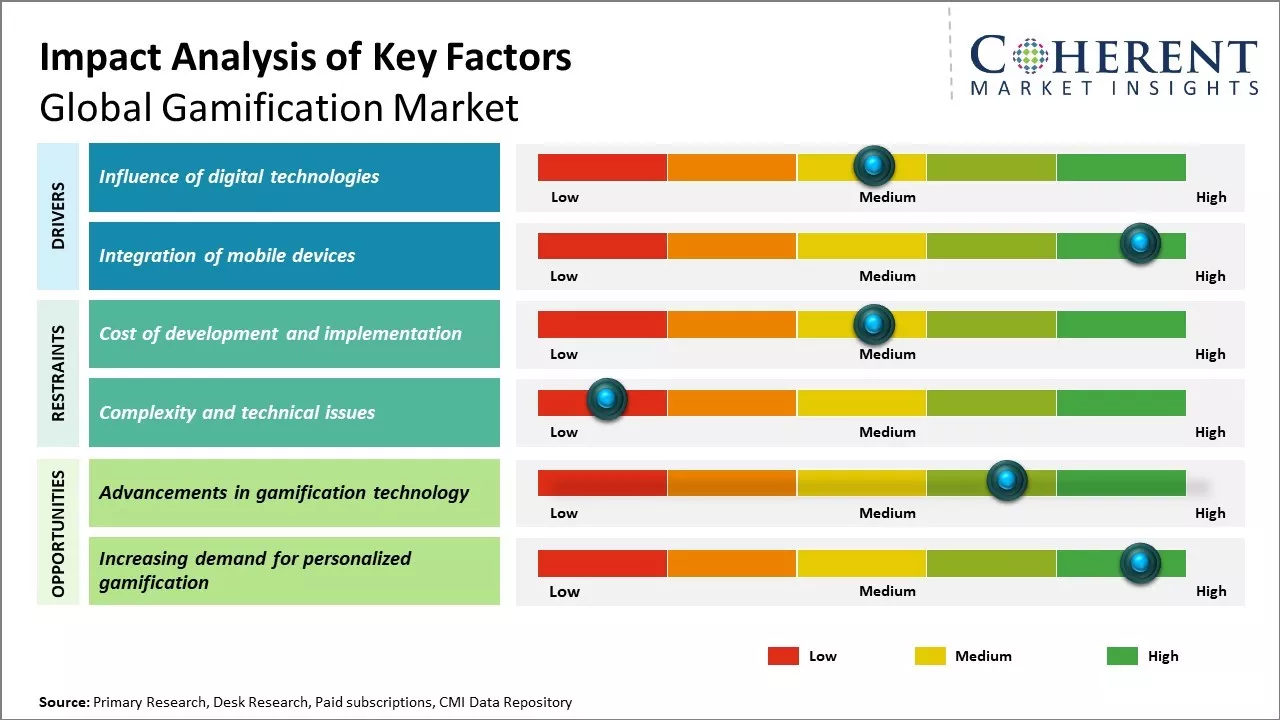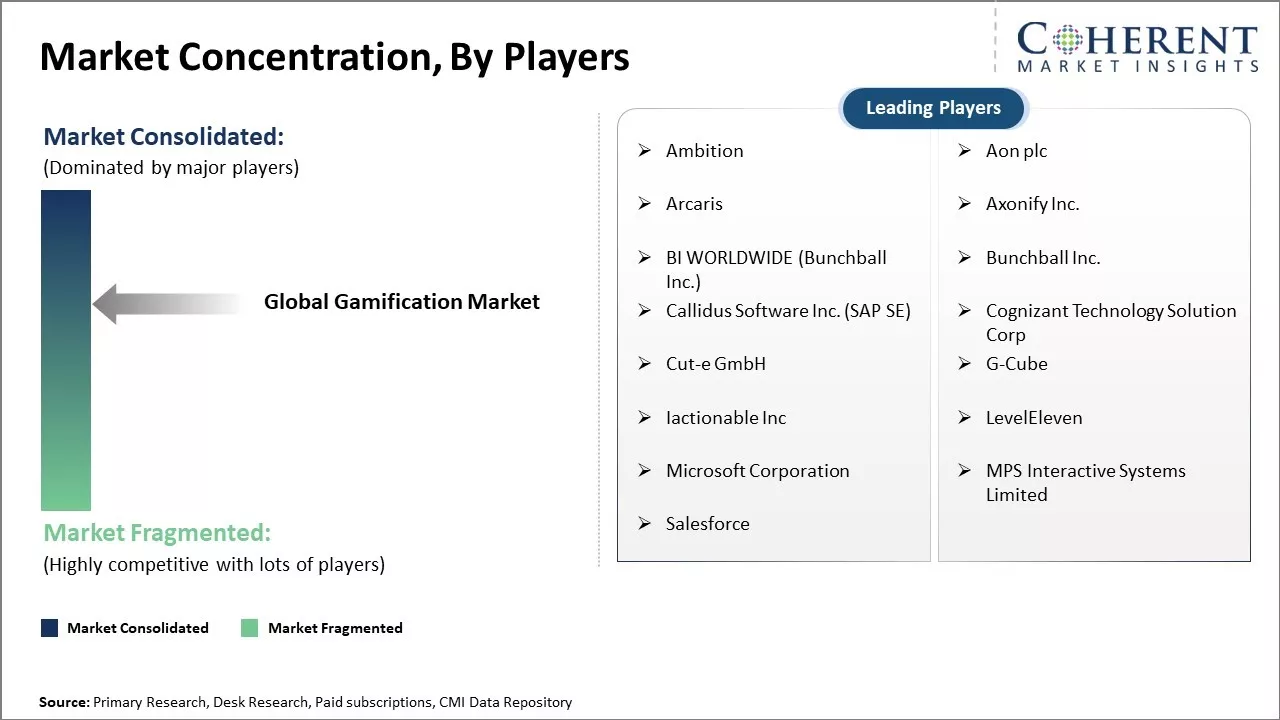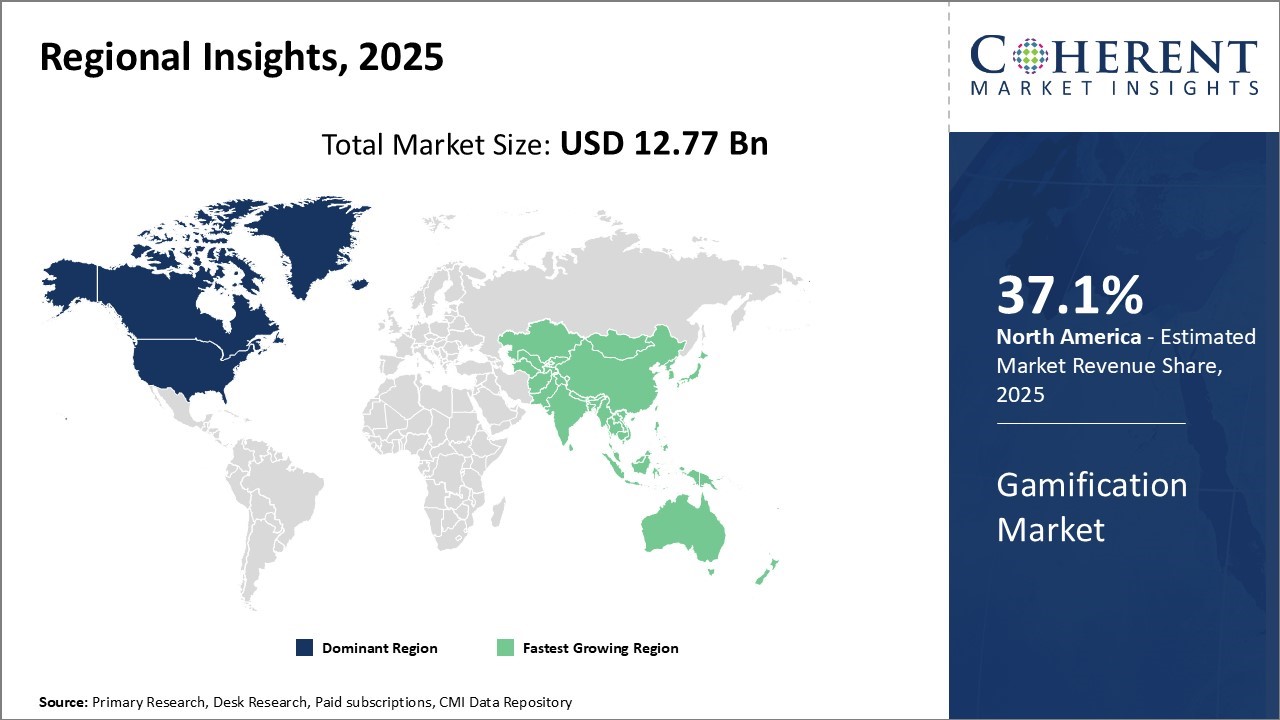Global gamification market is estimated to be valued at USD 12.77 Bn in 2025 and is expected to reach USD 62.29 Bn by 2032, exhibiting a compound annual growth rate (CAGR) of 25.4% from 2025 to 2032.

To learn more about this report, Download Free Sample
Global gamification market is expected to witness growth over the forecast period due to increasing adoption of gamification across various end use industries such as education, retail, healthcare, and others. Gamification offers various benefits such as increased customer engagement levels, higher productivity and motivation of employees. Moreover, growing usage of smartphones and emergence of cloud computing provides opportunities for market players to offer innovative solutions. Integration of advanced technologies such as artificial intelligence and augmented reality with gamification solutions can offer lucrative opportunities for the market growth during the forecast period. However, technical complexities in developing gamified solutions poses a major challenge for gamification vendors.
|
Current Events |
Description and its impact |
|
AI-Driven Personalized Gamification Systems |
|
|
Immersive AR/VR Gamification Experiences for Customer Engagement |
|
Uncover macros and micros vetted on 75+ parameters: Get instant access to report
Global gamification market pricing—covering software platforms, integration services, and support—is extremely diverse and dependent on deployment models, size of the enterprise, and functionality scope. Large enterprises are ruled by enterprise licensing models, particularly those opting for on‑premises deployment. Pricing is usually in the form of multi-tiered yearly subscriptions that can range from $100,000 to $500,000+, based on the user base size and customization requirements.
Cloud-based SaaS solutions, popular among SMEs, have more level‑out tiering structures: standard pricing bands begin at $10 to $50 per user per month, with volume discounts. Flat rate tiers, like basic, standard, and premium, are available on some platforms, with per‑user limits or feature ceilings.
Add-on professional services such as onboarding, content development, integrating analytics, and maintenance cost between 20–40% additional on base license rates. Brand alignment or vertical-specific gamification usually drives the price up.
Pricing models also increasingly involve performance‑based or value‑based structures, where payments are tied to measures such as uplift in engagement, completion rates for training, or loyalty program conversion. Some SaaS products bill on a revenue‑share or tiered usage basis—though these pricing models have been criticized as lacking transparency and fairness.
Overall, the pricing environment balances value received (learning outcomes, engagement, ROI) with flexibility and performance-based models to allow large businesses and expanding SMEs alike to leverage gamification tools that meet their budget and strategy.
Emerging technologies are profoundly revolutionizing the gamification industry, enhancing experiences to become more interactive, adaptive, and scalable across sectors. Artificial Intelligence (AI) is leading the way by powering personalized gamification through dynamically changing tasks, incentives, and feedback in response to user actions and engagement habits. AI-powered analytics also enable businesses to track performance in real time and fine-tune strategies for better results in learning, productivity, and customer loyalty.
Augmented Reality (AR) and Virtual Reality (VR) are increasing gamified environment immersion, particularly in industries such as retail, education, and employee development. Users can engage with branded or educational content in simulated lifelike experiences through AR/VR, leading to heightened motivation, engagement, and retention. Such technologies are particularly potent in developing emotional connections with users, and thus gamified experiences tend to be memorable.
Blockchain technology is being brought into gamification ecosystems to facilitate open reward systems, digital tokenization, and secure tracking of achievement. This is particularly significant in loyalty programs and decentralized learning platforms, where users are looking for verifiable outcomes and rewards that have real-world value.
In addition, the emergence of wearable technology and IoT devices has created opportunities for gamification of fitness and well-being, in which user data such as steps taken, heart rate, or sleep patterns can activate challenge, reward, and feedback loops in real-time.
These new technologies are remodeling gamification platforms' capabilities—shifting from passive point-and-badge mechanisms to active, intelligent, and multi-sensory journeys. With this, companies achieve more profound user interaction, improved data insight, and sustained loyalty, while users have more engaging and customized experiences.

To learn more about this report, Download Free Sample
The advent of digital technologies and their widespread integration into daily lives has significantly influenced consumer behavior and engagement. The younger generations have become accustomed to gamified experiences across various online and digital platforms. From achieving milestones on social media to collecting rewards and monitoring engagement through leaderboards on e-commerce sites, the concepts of levels, challenges, and accomplishment feedback have become deeply integrated into the digital landscape.
The gaming paradigm has created an inherent expectation of excitement, fun, and engagement from digital products and services. Users, particularly the younger generations, have come to anticipate and demand that digital offerings provide an engaging and enjoyable experience akin to gaming. This influences people's motivation to use newer technologies as well as stick with applications over a longer period of time. Enterprises recognize the importance of fulfilling these expectations to attract and retain customers in highly competitive digital environments.
Gamification equips businesses and developers with the means to incorporate elements of playfulness, achievement, and social interaction into their digital offerings. This allows them to create engaging experiences for audiences who have become accustomed to and expect gamified interactions across various online platforms and services.
The widespread adoption of smart mobile devices has transformed how people engage with technology and spend their time on digital activities. Mobile platforms have become indispensable for both work and entertainment, with users dedicating a significant portion of their day to mobile apps and services. This has opened new avenues for businesses to reach consumers in a personalized, immediate, and interactive manner.
However, the mobile format poses challenges in maintaining user attention and engagement amidst constant distractions and competing apps. Gamification addresses this issue by enabling purposeful and rewarding interactions within the constraints of mobile usage patterns. Game design concepts like push notifications, frequent feedback loops, and contextual challenges help foster habitual, long-term use of apps. Elements such as notifications, leaderboards, and achievements can inject fun prompts for users to engage proactively with an app.
Furthermore, the intimate and always-accessible nature of mobile devices helps internalize the virtual rewards and achievements from gamified experiences into real life. Enterprises are tapping into the engagement potential of gamification to develop "playful" and "sticky" mobile experiences that maximize user value and retention in this device-centric era.
Advancements in gamification technology present a great opportunity for the global gamification market to grow. As gamification becomes integrated across more industries and services, it allows businesses to better engage with customers, employees, and partners.
Several businesses are realizing they can use strategic gamification principles and design elements to motivate desired behaviors. By incorporating features like leveling up, badges, and rewards, they are seeing users actively participate in challenges, which overall improves outcomes like financial health.
When applied thoughtfully, gamification can lead to strong business results such as increased sales, higher productivity, and better customer retention rates. As millennials and Gen Z, who have grown up with gaming, become a larger part of the workforce and customer base, their preferences for gamified experiences will continue rising in the near future.
By component, services segment is estimated to contribute the highest market share of 58.7% in 2025. Gamification platforms require custom configuration and tailoring features to meet the unique needs and objectives of each business. The design and development process involves understanding customer behaviors, refining gaming mechanics, testing ideas, and continuous improvements based on collected analytics.
Services providers assist with end-to-end deployment from information gathering and brainstorming sessions to launch support. Companies benefit from experienced consultants who can navigate the complexities of aligning incentives, balancing challenges and rewards, ensuring user engagement remains high over the long-term.
As gamification evolves to influence a wider range of functions, there has been huge demand for specialized or niche services around application development, integration, data visualization, and training. Businesses are willing to invest more for personalized workshops to maximize results from these platforms. Managed services are gaining favor as well to eliminate the need for in-house resources and gain ongoing access to the latest developments in this fast-paced domain.
The services category within the gamification industry can witness growth due to reliance on external experts during planning and execution phases. Custom solutions hold higher chances of success as compared to generic products requiring internal customization efforts. Technological capabilities are continuously improving to engage and motivate modern digitally-native workforces and consumers.
Among deployment type, on-premise segment is estimated to contribute the highest market share of 56.9% in 2025, due to security and compliance needs of organizations. Enterprise customer data involving financial records, healthcare profiles or proprietary research often cannot be placed in cloud environments with less oversight of infrastructure and potentially relaxed access controls.
On-premise platforms allow businesses to house all mission-critical applications and associated information on local servers situated within their physical boundaries. This ensures absolute control over cyber defenses and real-time monitoring abilities. Any access by external parties gets meticulously governed and logged according to internal protocols. Such rigorous safety measures inspire confidence for deploying engagement solutions handling sensitive employee or client databases.
Low-latency on-premise systems are more responsive than cloud-based networks requiring data transmission over the internet. This delivers optimum end user experiences especially for real-time gamified training modules or industrial applications. Organizations embracing cutting-edge technologies leverage local hardware capabilities to their fullest potential.
System uptime guarantees hold more credibility when infrastructure maintenance remains an in-house function. On-premise platforms provide shelters against outages due to public cloud service disruptions beyond the enterprise's control. These advantages offset generally higher set-up expenses for hardware procurement and facilities as compared to subscription-based cloud services.
Robust security postures encourage regulated industries and large enterprises with vast compilations of classified operational or financial intelligence to prioritize on-premise gamification deployments for in the near future.
By end-use industry, retail on-premise segment is estimated to contribute the highest market share 35.6% in 2025 due to continued efforts to optimize customer engagement through rewards-based shopping experiences. Interactive applications are revolutionizing how consumers browse products and get influenced into purchases.
Gamifying the retail process through loyalty programs, reviews, referrals and other social features has grown into a highly effective engagement strategy. Rewards motivate repeat visits and incentivize trials of new items. Leaderboards and achievements stimulate competition between friends and followers. Such mechanics translate browsing hours into more qualified sales leads and transactions for merchants.
Especially for fashion, cosmetics and discretionary goods retailers, gamification improves emotional connections with shoppers of all demographics. Live 360-degree views and customizability in virtual try-on solutions establish deeper relationships as compared to traditional e-commerce platforms.
Omnichannel integration synchronizes the gamified experiences across stores, mobile, social media and websites based on individual profiles. This level of personalized interactions bolsters customer retention in a dynamic industry facing threats from rival digitization efforts and private labels.

To learn more about this report, Download Free Sample
North America has established itself as the dominant region in the global gamification market with an estimated market share of 37.1% in 2025. The region is home to major tech companies and game developers that are pioneering the use of gamification across various industries. Several large corporations in sectors such as education, healthcare and enterprise training have incorporated gamification into their systems to boost user engagement and productivity.
The high emphasis on innovation and technology adoption across different domains has provided a boost to the gamification vendors in North America. There is a presence of skilled workforce that is supporting research and development of new gamification tools and platforms.
Compared to other regions, organizations in North America are more willing to invest in experiments around gamification to reap benefits. The established gaming culture and higher per capita spending on digital games has created more awareness and acceptance of gamification-led initiatives.
Asia Pacific region is witnessing the fastest growth and has emerged as lucrative market for gamification vendors. Rapid digitalization of businesses along with rising internet and smartphone adoption in countries like India and China boosts the need for innovative engagement strategies like gamification. Sectors like education and e-commerce in Asia Pacific are increasingly shifting to gamification to attract new users and keep them engaged.
The Asia Pacific region has a large young population that is receptive to gamification trends, and rising disposable incomes allow organizations to invest in new technologies like gamification at scale. This has prompted multinational corporations to focus on this region for global gamification product expansion. For many Asia-based companies, gamification provides a domestic competitive advantage to compete against global rivals. The lower pricing of gamification tools compared to developed markets also contributes to increased adoption in the region.
The United States dominates the worldwide gamification market because of its cutting-edge technology infrastructure and high rates of adoption in sectors such as education, healthcare, and corporate training. Large technology corporations and startups regularly innovate gamification platforms, with the help of substantial investments in AI and AR technologies.
China's fast expanding online economy and extensive base of smartphone users make it a significant contributor to the gamification market. The government initiative for smart education and digitalization of retail and healthcare industries is fueling demand particularly in mobile gamification market.
Germany leads the gamification market in Europe due to its well-developed industrial and educational industries. Its emphasis is on gamified training for employees and industrial solutions, utilizing its strong experience in engineering and software development to deliver tailored gamification solutions.
India is a developing gamification hub, driven by a growing IT industry and high levels of smartphone penetration. Growing usage of gamified e-learning portals and mobile-driven promotions are the most notable drivers of growth, complemented by a young tech-conscious population.
| Report Coverage | Details | ||
|---|---|---|---|
| Base Year: | 2024 | Market Size in 2025: | USD 12.77 Bn |
| Historical Data for: | 2020 To 2024 | Forecast Period: | 2025 To 2032 |
| Forecast Period 2025 to 2032 CAGR: | 25.4% | 2032 Value Projection: | USD 62.29 Bn |
| Geographies covered: |
|
||
| Segments covered: |
|
||
| Companies covered: |
Ambition, Aon plc, Arcaris, Axonify Inc., BI WORLDWIDE, Bunchball Inc., Callidus Software Inc. (SAP SE), Cognizant Technology Solution Corp, Cut-e GmbH, G-Cube, Iactionable Inc, LevelEleven, Microsoft Corporation, MPS Interactive Systems Limited, Salesforce |
||
| Growth Drivers: |
|
||
| Restraints & Challenges: |
|
||
Uncover macros and micros vetted on 75+ parameters: Get instant access to report
Share
Share
About Author
Monica Shevgan has 9+ years of experience in market research and business consulting driving client-centric product delivery of the Information and Communication Technology (ICT) team, enhancing client experiences, and shaping business strategy for optimal outcomes. Passionate about client success.
Missing comfort of reading report in your local language? Find your preferred language :
Transform your Strategy with Exclusive Trending Reports :
Frequently Asked Questions
Joining thousands of companies around the world committed to making the Excellent Business Solutions.
View All Our Clients